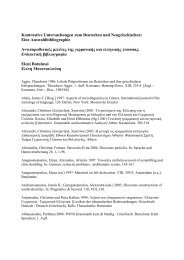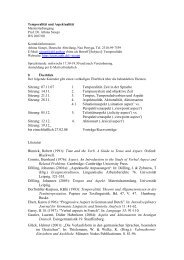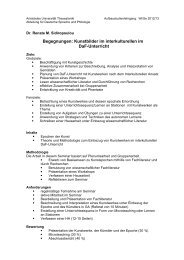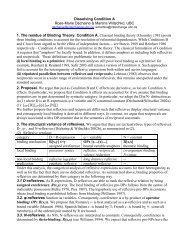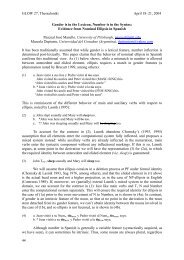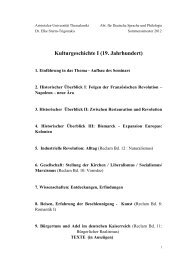Anna Cardinaletti (Venice) and Ur Shlonsky
Anna Cardinaletti (Venice) and Ur Shlonsky
Anna Cardinaletti (Venice) and Ur Shlonsky
You also want an ePaper? Increase the reach of your titles
YUMPU automatically turns print PDFs into web optimized ePapers that Google loves.
GLOW 27, Thessaloniki April 18–21, 2004<br />
Clitic Positions, Restructuring <strong>and</strong> Verbal Representations in Italian<br />
<strong>Anna</strong> <strong>Cardinaletti</strong> – University of <strong>Venice</strong><br />
<strong>Ur</strong> <strong>Shlonsky</strong> – University of Geneva<br />
We argue that there are two clitic positions in Italian ‘restructured’ clauses, (§1). One position<br />
is associated with the (restructured) lexical verb <strong>and</strong> the other is a clausal clitic position<br />
located in the functional domain. While restructuring can be recursive, clitics appear either on<br />
the restructured infinitive (no clitic climbing) or in the functional domain of the highest verb<br />
(full climbing). Climbing to an intermediate restructuring verb is impossible. We claim that<br />
only the lowest in a series of restructured verbs makes available a position for clitics. We then<br />
discuss the distribution of the infinitive-final [e] (as in amare) <strong>and</strong> argue that its position<br />
should be identified with the lexical clitic position, (§2). In (§3&4), we show that the<br />
functional ~ lexical dichotomy is too sharp <strong>and</strong> that different functional verb classes must be<br />
admitted, manifesting different subsets of restructuring properties. The properties exhibited by<br />
each class of verbs correlate with their position in the functional hierarchy. §5 attempts to<br />
provide a rudimentary structural representation of the domains projected by lexical <strong>and</strong><br />
functional verbs.<br />
1. The following sentences are representative of a typical restructuring pattern, Rizzi 1982.<br />
The pronoun ci ‘there’ can appear as a clitic either on the infinitival lexical verb <strong>and</strong>are ‘go’,<br />
by which it is selected, as in (1a), or on the inflected matrix verb volere ‘want’, as in (1b). The<br />
latter sentence illustrates clitic climbing.<br />
(1) a. Vorrei <strong>and</strong>arci con Maria.<br />
(I) would-want (to) go.there with Maria.<br />
b. Ci vorrei <strong>and</strong>are con Maria.<br />
When there is more than one restructuring verb in the clause, the clitic can appear on the<br />
infinitival lexical verb <strong>and</strong>are ‘go’ as in (2a), on the infinitival modal verb potere ‘can’ in<br />
(2b) or on the inflected modal verb volere ‘want’, (2c).<br />
(2) a. (?)Vorrei poter <strong>and</strong>arci con Maria.<br />
(I) would want (to) be able (to) go.there with Maria<br />
b. Vorrei poterci <strong>and</strong>are con Maria.<br />
c. Ci vorrei poter <strong>and</strong>are con Maria.<br />
Clitic climbing is, however, subject to a hitherto unnoticed restriction. If an auxiliary is<br />
added to (2) <strong>and</strong> auxiliary switch applies (an independent diagnostic for restructuring), not all<br />
three options in (2) yield acceptable results. What we find is that the non-climbing <strong>and</strong> the<br />
‘full’ climbing options are substantially better than the partial climbing one (with full<br />
climbing perhaps better than non-climbing). This contrast is illustrated in (3): Partial climbing<br />
to potere in (3b) is ungrammatical.<br />
(3) a. ?Sarei voluto poter <strong>and</strong>arci con Maria.<br />
(I) would –be wanted (to) be able (to) go.there with Maria<br />
b. *Sarei voluto poterci <strong>and</strong>are con Maria.<br />
c. Ci sarei voluto poter <strong>and</strong>are con Maria.<br />
The following generalization thus emerges.<br />
(4) Clitic pronouns can appear attached either to the lexical verb or to the highest verb that<br />
has restructured <strong>and</strong> nowhere else.<br />
(2b) is grammatical because, in the absence of an auxiliary, restructuring applies only up to<br />
poter so that vorrei is actually in a higher clause. Thus, clitic climbing in (2b) is consistent<br />
with (4), while climbing in (3b) is not.<br />
Assuming a monoclausal approach to restructuring, as in Cinque 2004, the generalization<br />
in (4) can be captured by saying that the clause contains two clitic positions. In addition to the<br />
clausal clitic position situated in the high portion of the IP (cf. Kayne 1989, 1994) a lexical<br />
clitic position must also be assumed. This clitic position is associated with the lexical verb as<br />
28
Main Session Abstracts<br />
part of the lexical or VP domain (vP or a like projection). (5) schematizes the two clitic<br />
positions.<br />
(5) [FP … [FP clitic [FP … [FP … [FP clitic [vP [VP ]]]]].<br />
|______________________| |_____________|<br />
functional domain lexical domain<br />
2. Italian lexical infinitives invariably display a word-final [e]. [e] is obligatorily absent in the<br />
presence of an enclitic pronoun, as in (6b).<br />
(6) a. Le vorrei parlare b. Vorrei parlar(*e)le<br />
(I) to her would want (to) speak (I) would want (to) speak to her<br />
There is no phonological motivation for this apparent truncation. The rule of Troncamento<br />
- which deletes a word-final /e/ or /o/ before a consonant-initial word if the target vowel is<br />
preceded by a sonorant consonant, (Peperkamp 1997) – is optional. The absence of [e] in (6b)<br />
is obligatory. We argue that the infinitive-final [e] is a morpheme. Indeed, it is the realization<br />
of the same low position which clitics target in e.g. (1a), (2a), <strong>and</strong> (3a). Although it appears<br />
that the final [e] is deleted in (6b), we argue that it is actually there, as the final vowel of the<br />
clitic le. The morphological makeup of parlarle is thus parlar-l-e. The clitic adjoins to the [e],<br />
which realizes the lexical clitic position. In fact, the underlying form of the infinitive-final<br />
vowel is /i/, as is the final vowel of the clitics mi, ci, vi etc. The [i]~[e] alternation is<br />
phonologically conditioned: /i/ [e] following a coronal sonorant. This rule lowers /e/ to [i]<br />
following the stem-final /r/ in infinitives.<br />
Although [e] may be absent on clitic-less lexical infinitives in Troncamento contexts, it<br />
must be absent on modal <strong>and</strong> volitional predicates in their restructuring guise.<br />
(7) *Sarei voluto potere partire con Maria.<br />
Again, no phonological explanation is available for the absence of [e] in this context. We<br />
argue that [e] is absent from intermediate restructuring verbs for exactly the same reason that<br />
clitics cannot attach to them (as we saw in (4)). Compare (7) with (3b).<br />
3. Restructuring verbs are not a homogeneous class (see also Wurmbr<strong>and</strong> (forthcoming)). For<br />
example, causative <strong>and</strong> perception verbs (as well as motion verbs) are restructuring verbs that<br />
do not trigger auxiliary switch, (8b), can host a clitic, (8c), <strong>and</strong> display the infinitival [e], (8d).<br />
(8) a. L’ho fatto/visto partire. b. *Lo sono fatto/visto partire.<br />
(I) him have made/seen leave (I) him am made/seen leave<br />
c. Vorrei farlo leggere a Maria. d. Lo vorrei fare leggere a Maria.<br />
(I) would-want (to) make.it read to Maria<br />
4. There is a correlation between the properties displayed by restructuring verbs <strong>and</strong> their<br />
position in the functional hierarchy in (9) (cf. Cinque(forthcoming2004).) Modal <strong>and</strong><br />
volitional verbs appear highest in the hierarchy. The class of causative, perception <strong>and</strong> motion<br />
verbs - underlined in (9) - appear in the lower part of this hierarchy, below Voice <strong>and</strong> above<br />
the domain of “VP-adverbs”.<br />
(9) > Modvolition > … > Modobligation …> Mod permission …> Voice > Perception ><br />
Causative > … > Andative > Completive > … VP<br />
5. The difference between lexical verbs <strong>and</strong> the verbs underlined in (9), on the one h<strong>and</strong>, <strong>and</strong><br />
between these <strong>and</strong> the other restructuring verbs, on the other, is that they project shells of<br />
different sizes. Lexical verbs are endowed with a full shell, including vP <strong>and</strong> the lexical clitic<br />
or [e] position. In addition, lexical verbs select an auxiliary, the choice of which depends on<br />
the way the arguments are aligned in the shell. The verbs underlined in (9) are associated with<br />
a reduced shell, a fact which we relate to the limitations on their argument structure. Finally,<br />
the other restructuring verbs lack a shell altogether. These are simply merged in functional<br />
heads. To put it concisely, lexical verbs <strong>and</strong> the verbs underlined in (9) are associated with a<br />
richer structure than fully functional verbs. However, the split between lexical <strong>and</strong> functional<br />
verbs is not clear-cut. Rather, there is a gradation from structurally rich to structurally poor<br />
verbal representations.<br />
29
GLOW 27, Thessaloniki April 18–21, 2004<br />
Reference List<br />
Cinque, Guglielmo. forthcoming. "Restructuring" <strong>and</strong> functional structure. In The structure of<br />
CP <strong>and</strong> IP, ed. by Luigi Rizzi. New York: Oxford University Press.<br />
Kayne, Richard S. 1989. Null Subjects <strong>and</strong> clitic climbing. In The Null Subject Parameter, ed.<br />
by Osvaldo A. Jaeggli <strong>and</strong> Ken Safir, 239-261. Dordrecht: Kluwer Academic Publishers.<br />
Kayne, Richard S. 1994. The Antisymmetry of Syntax. Cambridge, MA: MIT Press.<br />
Peperkamp, Sharon. 1997. Prosodic Words. The Hague: Holl<strong>and</strong> Institute of Generative<br />
Linguistics.<br />
Rizzi, Luigi. 1982. A restructuring rule. In Issues in Italian syntax, ed. by Luigi Rizzi, 1-76.<br />
Dordrecht: Foris.<br />
Wurmbr<strong>and</strong>, Susi. forthcoming. Two types of restructuring: Lexical vs. functional. Lingua.<br />
30



